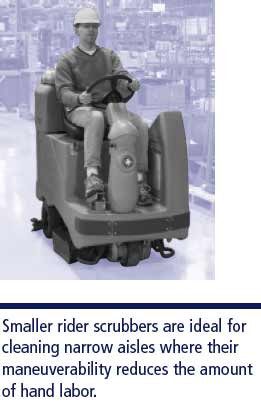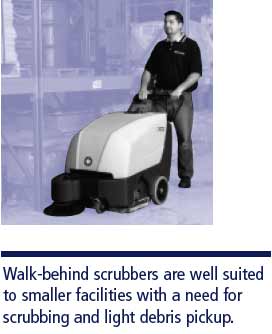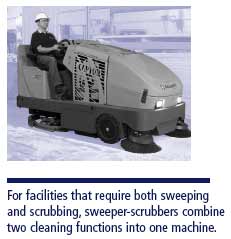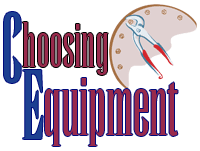How to Select Industrial Floor-care Equipment
Proper Machines are a Key to Increased Productivity and Performance
by Dave Ditty, Training Manager
Advance Sweepers
A clean working environment helps promote worker safety, productivity and
product quality. That's why the floor-cleaning equipment you select for
your plant is nearly as important as the manufacturing equipment you select. In
addition, the cleanliness of your plant, warehouse or machine shop conveys a
quality image that carries over into higher employee morale and positive
reactions from visiting customers and vendors. In short, keeping the workplace
clean adds real value to virtually any enterprise.
Just about every facility will require a combination of floor-care equipment from
brooms to vacuum cleaners to walk-behind scrubbers or rider sweepers. Getting the right mix of equipment is a matter of assessing your specific cleaning needs.
 Some of the factors that affect this decision include:
Some of the factors that affect this decision include:
- The size of dirt and debris particles generated
- The amount of dirt and debris generated
- The character of the dirt (fibrous, oily, dusty, wet)
- The type of surface (tile, bare concrete, coated concrete, outdoor, etc.)
- The number of personnel involved in cleaning activities
A definition of what constitutes 'clean' for your facility
On this last point, 'clean' can mean anything from getting rid of chunks of dirt
on the floor to creating a shiny, scuff-free surface. Your facility's cleanliness goal will be a factor in your equipment choice. For example, if 'clean' means getting rid of forklift tire marks and other stains in addition to dust and debris, then your cleaning process will have to include scrubbing as well as sweeping.
SWEEP OR SCRUB?
After assessing the size and amount of dirt and debris to be removed, the
primary decision to be made is 'sweep vs. scrub.' This decision is not always
straightforward. For example, if the material to be cleaned is mostly fine dust, it
would seem that a sweeper would be the ideal tool to remove it. But the best
way to handle dust is to 'add water,' which eliminates your dust problem; this
means a scrubber may actually be the better equipment choice.
Sweepers are ideal for bulky debris such as wood chips, metal shavings (swarf),
paper and fibrous materials. Scrubbers are suitable for light, dusty debris on all
types of hard floors -- especially dirty or oily surfaces. In many instances, you
may need to sweep first and then scrub. This requires either two separate machines or one combination machine.
In smaller facilities, where only one
person is doing the cleaning, a combination sweeper/scrubber is often a good
choice because with two machines, one of them would sit idle a good share of
the time. However, combination sweeper/scrubbers, due to their dual function,
sometimes have limited hopper and tank capacities, which can reduce
productivity in the long run. More time spent dumping hoppers and refilling
solution tanks on combination machines can mean less active cleaning time.
WALK OR RIDE?
When you consider that 90 percent of the cost of cleaning is labor, the
additional cost of a ride-on machine can likely be recouped from labor savings
in about three months. This is because ride-on sweepers and scrubbers offer
productivity gains as much as 64 percent over walk-behind machines. In
addition, ride-on equipment is easier on your personnel, allowing them to do
more with less fatigue.
 Today's ride-on machines are compact enough to get into
narrow spaces, and many are nimble enough to turn within their own length.
By making more passes in a given time and significantly reducing worker
fatigue, ride-ons provide a big productivity boost for a modest investment.
Today's ride-on machines are compact enough to get into
narrow spaces, and many are nimble enough to turn within their own length.
By making more passes in a given time and significantly reducing worker
fatigue, ride-ons provide a big productivity boost for a modest investment.
EQUIPMENT SIZING
As a general rule of thumb, you should purchase the smallest walk-behind or
ride-on equipment that will allow you to complete your active sweeping or
scrubbing in no more than two to three hours (exclusive of dump and refill
cycles). For most companies, the person doing the cleaning is also responsible
for other jobs in the plant, and it's generally not economical to have him
spending more than half a day on cleaning. Look for machines with larger
capacity hoppers or solution tanks in order to minimize unproductive dump and
refill activities.
If you need to scrub a 9-foot-wide aisle, a 48-inch-wide machine will
accomplish that task in a minimum of three passes. While you might think that
a 50-inch-wide machine would get the job done more quickly, it doesn't. It will
still require three passes to complete the cleaning. This is a case in which a
larger and more expensive machine offers no gain in productivity. By matching
the size of the machine to your exact needs, you minimize your capital
investment while maximizing productivity.
In many instances, you may need a ride-on sweeper or scrubber for large open
areas and a smaller walk-behind sweeper or scrubber for narrow aisles or to get
in around and between individual workstations. Again, each machine you
choose should be the smallest practical size for the job in order to minimize
your investment.
TYPE OF FLOOR SURFACE
Most sweepers and scrubbers are intended to work on any hard floor surface,
but for best results, the style of brushes, brooms or squeegees you select should
be matched to your specific surface and the dirt or debris to be removed. For
example, some brooms are designed to sweep up fine dust from smooth floors.
Wire-reinforced brooms do a more aggressive job of cleaning and are ideal for
bulkier debris on unsealed concrete floors. There are even grit-impregnated
brooms and brushes for heavy-duty cleaning on rough surfaces.
Scrubbers used on smooth, sealed surfaces are usually equipped with soft gum
rubber squeegees that do an excellent job of getting up the excess water so the
floor can dry quickly. However, used on rough floors, a gum rubber squeegee
will wear too quickly, so synthetic squeegee blades should be specified. The
synthetic blades are not as flexible as gum rubber, but they last longer and also
resist degradation in greasy and oily environments.
 Other features to look for:
Other features to look for:
1. Ease of use - A key feature to look for in floor-cleaning equipment is ease
of use Ð especially if the equipment is going to be used by more than one
operator. Are the controls easy to understand? Can the equipment be used
with minimal training? Is the equipment designed to enable operators to
handle minor equipment problems? For instance, a sweeper with a main
broom that can be easily removed without tools will allow operators to
disentangle the tape, cords, packing material, etc., that can get wrapped
around the broom and reduce its sweeping ability. Unless these materials
can be easily and quickly removed, cleaning productivity will suffer.
2. Water usage/tank capacity - Choose scrubbers that offer reduced
water/detergent use and large solution tank capacities in proportion to their
size. These features will not only lower operating costs and help the
environment by reducing the volume of your waste stream, they will also
improve your cleaning productivity.
3. Operator visibility - Another consideration is whether the equipment gives
the operator a clear view of the area to be cleaned - for both safety and
cleaning performance reasons. While many sweepers have hoppers that
can be raised 60 inches to dump directly into a dumpster, it is important to
have a sweeper that allows the operator a clear view of the dumping
without having to lean his head outside of the machine. Whenever the
operator has to lean outside of the machine, there is a danger of striking
his head on a nearby rack or piece of equipment. Choose units with offset
hoppers that allow the operator to sit straight and look forward during both
dumping and sweeping operations.
MAINTAINING YOUR EQUIPMENT
When there are multiple users of a piece of equipment, it's important to assign
responsibility for maintenance and upkeep to one person. If no one takes
ownership of the unit, maintenance will often be neglected and lead to machine
failures. Look for manufacturers that offer preventive maintenance programs for
your floor-care equipment as a way to ensure high machine availability.
CONCLUSION
Because 90 percent of the cost of cleaning is labor, you will want to select floorcleaning
equipment that provides the highest productivity as well as the best
cleaning performance. A reputable local equipment dealer will be able to help
you choose the floor-cleaning equipment that is right for your application. Your
dealer will also make sure the equipment is right for your operators by providing
an in-plant trial of your selected machine. Working with your dealer, you can
make sure your operators are trained and preventive maintenance programs are
put in place to protect your investment for years to come.
 Advance produces a variety of floor cleaning equipment. For more information, go to www.advance-us.com. To reach the company by phone, in the U.S. call 800-214-7700; the toll free number in Canada is 800-668-8400.
Advance produces a variety of floor cleaning equipment. For more information, go to www.advance-us.com. To reach the company by phone, in the U.S. call 800-214-7700; the toll free number in Canada is 800-668-8400.
|

